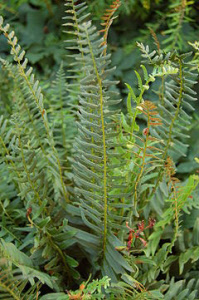Description
OUT OF STOCK
Leathery, lance-shaped evergreen fronds.
Leathery, lance-shaped evergreen fronds.
**LISTED AS OUT OF STOCK BECAUSE WE DO NOT SHIP THIS ITEM. IT IS AVAILABLE FOR PURCHASE AT OUR RETAIL LOCATION.
OUT OF STOCK
Leathery, lance-shaped evergreen fronds.
Small crimson-red bells dangle from July to September
Size: 8’ x 3’
Care: Full sun in humusy, fertile, moist well-drained soil. Mulch around the base. Flowers on current year’s stems so cut back to 6-8” in late winter or early spring.
The genus Clematis was named by Dioscordes, physician in Nero’s army, from klema meaning “climbing plant.” The species 1st collected by the “Father of Texas Botany” Ferdinand Lindheimer in 1830’s. Max Leichtlin of the Baden Botanic Garden sent C. texensis to Kew Botanic Garden in London in 1880. French nurseryman Francisque Morel sent this selection to William Robinson. Robinson named it for his English nursery at Gravetye Manor in 1914
OUT OF STOCK
Purple, upfacing bells for months in mid to late summer
Size: 4-6” x 20”
Care: full sun-part shade in moist well-drained soil
Native: Northern Yugoslavia
Awards: England’s Royal Horticultural Society Award of Merit. Top rated for ornamental traits and landscape performance by the Chicago Botanic Garden & Elisabeth Carey Miller Botanical Garden Great Plant Pick.
Campanula is Latin meaning “little bell.” This species named for one of its discoverers, Franz Edler von Portenschlag-Ledermayer (1772-1822). 1st described in Systema Vegetabilium 5: 93 in 1819
Profusion of small classic daisies May-July atop fragrant silver foliage. Cut back for rebloom. Let the seeds drop for more plants next year. If you cut them back after the 1st flowering they will rebloom for most of the summer and fall.
Size: 2’ x 3’
Care: sun in moist well drained soil
Native: central & southern Europe
Named by Carl Heinrich Schultz (1805-1867)
Fast-growing, pyramidal-shaped deciduous conifer. The orange to brown trunk base tapers and thickens with up to a dozen large buttress-like root flares extending several feet up the trunk. Feathery, fern-like, soft foliage emerges light green in spring, and turns red-bronze in fall before dropping. Its branches are well-attached and make excellent climbing.
Size: 70-90’ x 15-25’
Care: sun in moist to moist well-drained, slightly acid soil
Native: Szechuan China
Awards: Royal Botanic Garden Award of Garden Merit, Yew Dell Botanical Gardens’ Theodore Klein Plant Awards & Pennsylvania Horticultural Society Gold
From fossil records, dawn redwood is known to have existed as many as 50,000,000 years ago. However, it was not until 1941 that dawn redwood was first discovered growing in the wild near the town of Modaoqi China by Chinese forester, T. Kan. Seeds collected from the original site were made available to the Missouri Botanical Garden in 1947. Seedlings grown therefrom were planted in front of the Lehmann Building at MBG in 1952 where they have now developed into large mature trees (70’+ tall). Dawn redwood is a deciduous, coniferous tree that grows in a conical shape to 100’ tall. It is related to and closely resembles bald cypress (Taxodium) and redwood (Sequoia).

